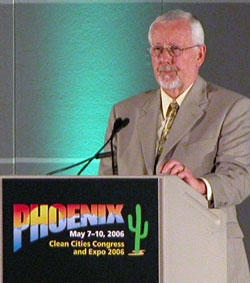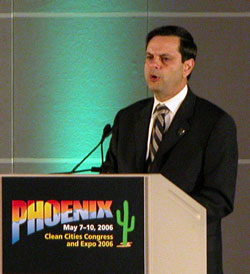Governor George E. Pataki announced nearly $6 million in State funding to assist Western New York Energy in the development of the first state-of-the-art dry mill ethanol plant in New York State. The $87.4 million facility is to be located on 144 acres in the Town of Shelby, Orleans County.
BioEnergy International, a privately held, biotechnology company headquartered in Norwell, Massachusetts, announced that it has commenced site work on its first biorefinery, a 108 million gallon per year ethanol plant located on land leased from the Lake Providence Port Commission in East Carroll Parish, Louisiana.
VeraSun Energy broke ground on its third ethanol biorefinery in Charles City, Iowa over the weekend. When complete, the biorefinery will produce 110 million gallons of ethanol and 353,000 tons of distillers dried grains (DDGs) annually from 39 million bushels of corn.
 One of the ways we moved people here at the Congress was with a Hybrid Bus that took us out to the opening reception.
One of the ways we moved people here at the Congress was with a Hybrid Bus that took us out to the opening reception.



 Increased awareness of domestic fuel alternatives is helping organizers of the 2nd Annual
Increased awareness of domestic fuel alternatives is helping organizers of the 2nd Annual  This has absolutely nothing to do with alternative fuels unless you consider that this blogger needed “fuel” and got it in the form of some fine Irish stew at
This has absolutely nothing to do with alternative fuels unless you consider that this blogger needed “fuel” and got it in the form of some fine Irish stew at  Our keynote speaker at lunch today was Robert Howard, VP of Corporate Planning and Logistics for
Our keynote speaker at lunch today was Robert Howard, VP of Corporate Planning and Logistics for 
 As I mentioned in an earlier post today,
As I mentioned in an earlier post today,  Right now there are numerous workshops and sessions taking place here at the Congress. I wish I could cover them all. Pictured here is Robert Jay Gordon, President/Co-Publisher of
Right now there are numerous workshops and sessions taking place here at the Congress. I wish I could cover them all. Pictured here is Robert Jay Gordon, President/Co-Publisher of  James Boyd is a member of the
James Boyd is a member of the  On this morning’s agenda was Dr. Robert Hirsch, Senior Program Advisor, Science Applications International Corporation.
On this morning’s agenda was Dr. Robert Hirsch, Senior Program Advisor, Science Applications International Corporation. Welcoming everyone to the Clean Cities Congress this morning was
Welcoming everyone to the Clean Cities Congress this morning was